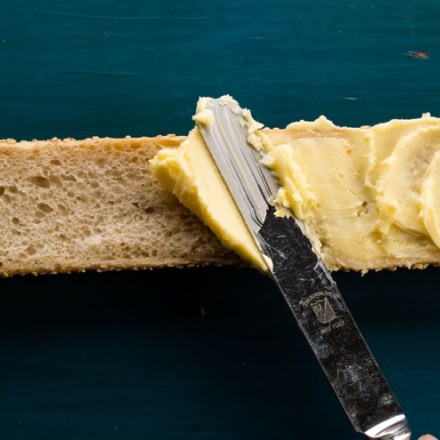Ingredients
| 940 g | heavy cream |
| 30 g | buttermilk |
| 1.5 g | salt (optional) |
| 1 quart heavy cream |
| 2 tablespoons buttermilk |
| ¼ teaspoon salt (optional) |
Essential Equipment
Instructions
- 940 g heavy cream
- 30 g buttermilk
- Chill cream to 55 to 60 degrees F/10 to 15.5 degrees C.
- Transfer cream to food processor and process until mixture turns from grainy whipped cream to lumps of butter splashing in liquid, 1 to 3 minutes. Stop processor immediately.
- Fill medium bowl halfway with ice and water. Line fine-mesh strainer with triple layer of cheesecloth, leaving few inches of cloth hanging over sides of strainer. Pour butter mixture through cheesecloth-lined strainer into large bowl (buttermilk will collect in bowl). Lift cheesecloth by edges and twist and squeeze tightly over strainer to press out more buttermilk (when butter starts to squeeze through cheesecloth, you are done). Transfer cheesecloth-wrapped butter to ice bath until firm around exterior, about 2 minutes. Transfer buttermilk to airtight container; do not wash bowl.
- 1.5 g salt (optional)
Instructions
- 1 quart heavy cream
- 2 tablespoons buttermilk
- Chill cream to 55 to 60 degrees F/10 to 15.5 degrees C.
- Transfer cream to food processor and process until mixture turns from grainy whipped cream to lumps of butter splashing in liquid, 1 to 3 minutes. Stop processor immediately.
- Fill medium bowl halfway with ice and water. Line fine-mesh strainer with triple layer of cheesecloth, leaving few inches of cloth hanging over sides of strainer. Pour butter mixture through cheesecloth-lined strainer into large bowl (buttermilk will collect in bowl). Lift cheesecloth by edges and twist and squeeze tightly over strainer to press out more buttermilk (when butter starts to squeeze through cheesecloth, you are done). Transfer cheesecloth-wrapped butter to ice bath until firm around exterior, about 2 minutes. Transfer buttermilk to airtight container; do not wash bowl.
- ¼ teaspoon salt (optional)
